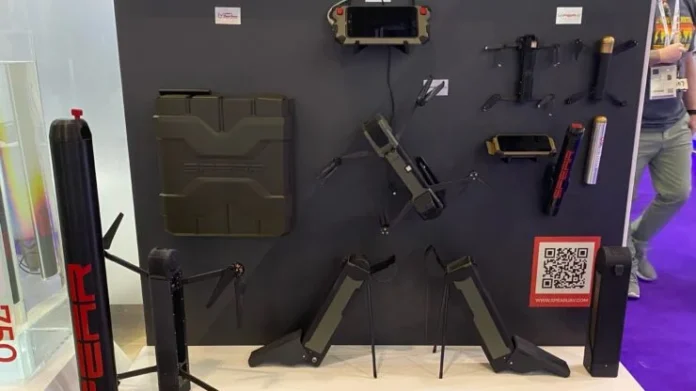London: Israeli defence companies are showing their latest wares at DSEI in London this year which includes new VTOL offerings to novel combinations of existing platforms.
Unveiling a new unmanned system at DSEI called Rotem Alpha, a new vertical takeoff and landing loitering munition, Israeli defence giant IAI said, ”It’s designed for anti-tank missions specifically and the system is man-portable.” Rotem Alpha is man-portable. Alternatively, it can be mounted on a vehicle. Carried in a backpack or deployed from a vehicle, this loitering munition is ready for takeoff in less than two minutes. As a VTOL platform, it can be launched and landed between trees, structures, and other types of harsh terrain.
“Rotem Alpha’s sensor suite autonomously detects and locates hostile enemy fires, like artillery, rockets, and missile launchers, and then investigates and engages a direct attack using its electro-optical day and night seeker,” the company said in a statement announcing the drone.
According to IAI, the tactical loitering munition represents a revolution in the technical and operational capabilities of loitering munitions. Equipped with a “field-proven” anti-tank warhead, a top-grade sensor suite, and long mission endurance, the Rotem Alpha has a long endurance in the air and when parked in perch mode. It can fly and hover at a low-altitude profile to build situational awareness and execute an attack, despite adverse weather conditions.
IAI’s president and CEO, Boaz Levy said, “Rotem Alpha is an innovative portable anti-tank loitering munition, leveraging IAI’s heritage of combat-proven Loitering Munitions. Rotem Alpha addresses the up-to-date requirements of the modern battlefield. It’s unique capabilities provide a key military advantage to the fighting unit.”
SpearUAV, another Israeli company, unveiled a multi-canister launcher (MCL), capable of being vehicle-mounted, for its Viper 300 UAV. According to the company, the model can carry a 300-gram payload, including a warhead that size.
Says Yiftach Kleinman, executive vice-president at SpearUAV, “The UAV system uses artificial intelligence to “distinguish between non-relevant and relevant targets”. It is “part of our in-house capabilities.”
Elaborating further, he states, “A lot of players build drones for infantry, but there isn’t a company that provides a solution for manoeuvring forces. SpearUAV produces drones stored inside a capsule so that they can be mounted on vehicles, as well as naval assets, such as submarines and launched on the go.”
Traditionally used for surveillance-related missions, the ability to use these systems to attack is new, Kleinman said. “The system has gone through a directional warhead “qualification process” with an unnamed customer. This is the breakthrough we have been through in the last three months. For many years Spear was perceived as more of an ISR company and here we show the ability to attack,” he said.
The multi-canister launcher is meant to make the capability relatively easy to fit on a vehicle, where a unit will have to balance good size, weight and power (SWAP) such that the operator gets more bang for the size of real estate the system takes up. The multiple-launch system also allows, for instance, for multiple drones to be launched so one can conduct surveillance for up to 30 minutes, while a loitering munition is then sent to strike a target.
Showing an example of the system mounted on a Boxer armoured fighting vehicle, a presentation from SpearUAV showed that in this configuration several capsules on the turret can launch drones that might include different payloads, such as one with ISR capabilities, one with EW and one with a munition. It could also be mounted on unmanned ground vehicles.
Without specifying any current procurement phases it is part of, Kleinman said the company is “in stages of integrating our MCL to their platforms. We are in the delivery phase to customers.”
At DSEI 2023, highlighting different unique ideas, Elbit Systems promoted not a new platform, but a new way to use two existing ones, the Skylark III and SkyStriker Loitering Munition. The Skylark III is an intelligence-gathering drone that can fly for up to 18 hours, while SkyStriker is a loitering munition with a 10-kilogram warhead that can fly for two hours up to 100 kilometres. Elbit has taken the two and combined them with what they call the “FAST [find and strike] Capsule,” where they can both be stored, carried, launched, operated and controlled by the same equipment and by the same crew.
According to Elbit, the drones are both launched from a “pneumatic” launcher, or a kind of catapult, and both “can be assigned to the same mission simultaneously managed by a shared Ground Control Station.” The idea is for one to do the spotting and the other do the attacking, without the normal complication that usually comes with using two different unmanned systems at the same time.













